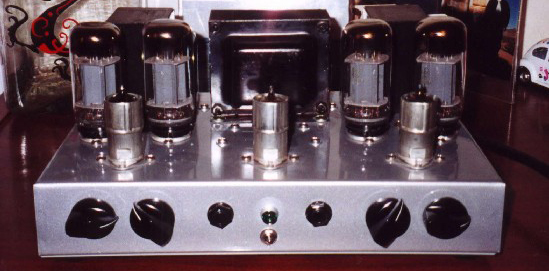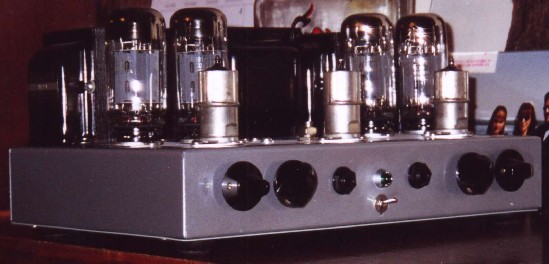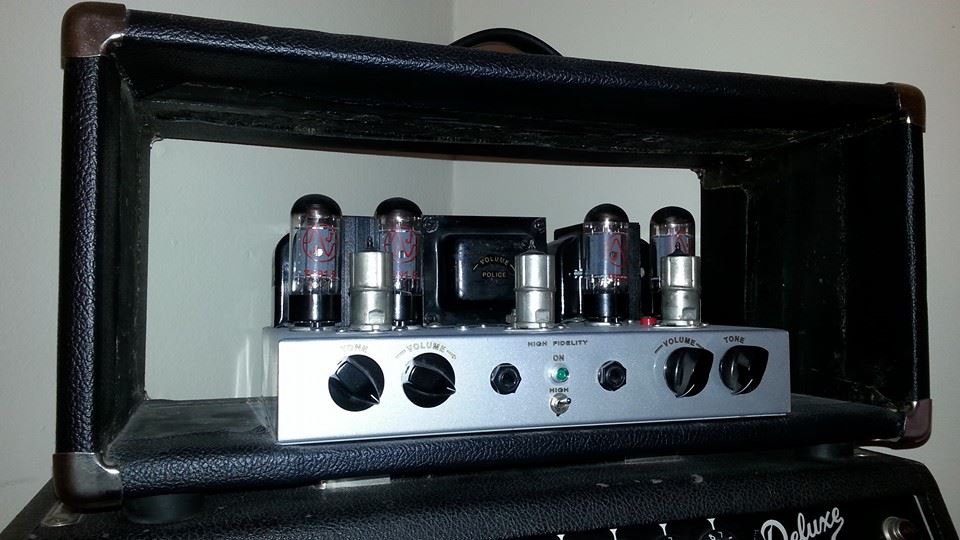Channel-Switching Preamp Mod for AB165 Fender Bassman
A PDF schematic of this mod is here....
The guitar used for these sound samples is a Lone Star Strat modded with Bill Lawrence L280/L280/L290 "single coil" style noise-cancelling pickups. The speaker is one of a pair of Mesa-Boogie MS-12 150 Watt "Black Shadow" speakers--the original type Black Shadow from the early '80s. These speakers reside in a pair of homebuilt 1x12" rear-ported cabinets. I recorded this with an AKG D3900 microphone right next to the speaker grille, using no EQ. The amp is tubed with EH EL34s, a Tung Sol 12AT7 in the PI, a JJ/Tesla ECC83S in the loop buffer/recovery slot, another ECC83S in the drive channel's second/third gain stages, and an old ('80s) EI 12AX7A in the input/CF stage.
Wind_Cries_Mary.mp3
The rhythm guitar is going through the clean channel, the clean channel volume is set to 5, the bright switch is on, the neck pickup is selected, and the guitar volume is full up. The lead guitar is through the overdrive channel, the gain is set to 4, the deep switch is off, the neck pickup is again selected, and the guitar volume is rolled back to about 7.
Boys_Are_Back.mp3
The guitar is going through the overdrive channel, the gain is set to 5, the deep switch is off, the bridge pickup is selected, and the guitar volume is full up. Harmonic feedback is easily attainable at this gain setting (indeed, it requires effort to avoid it...), even though the volume at which I recorded this clip is moderate, i.e., loud bedroom/basement practice volume.
VZA Simone 1x12" Combo
Under Construction!
Placeholder page for details about the VZA Simone 1x12" combo amp.
My Stereo Tube Guitar Power Amp
The Preamp circuit:
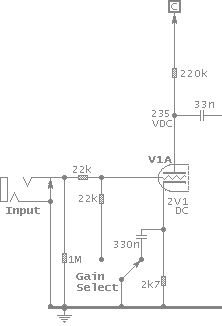 A fairly standard circuit, with a shelving treble boost located at 380 Hz for added mid and treble presence. I included a gain cut switch at the input to cut down the signal and input impedance for use with line-level devices. This switch also disables the treble boost, for a more "hi-fi" response appropriate for amplifying the processor I use, cleanly, with little coloration.
A fairly standard circuit, with a shelving treble boost located at 380 Hz for added mid and treble presence. I included a gain cut switch at the input to cut down the signal and input impedance for use with line-level devices. This switch also disables the treble boost, for a more "hi-fi" response appropriate for amplifying the processor I use, cleanly, with little coloration.
With a 12AX7 here, the gain and tone are not too far removed from the old 18W Marshall combo. With a 12AY7, the tone is nice and even for amping my processor. In either case, it cuts nicely through the wash of cymbals when the "Cut" control is turned up....
The voltages shown here are for a 12AX7.
The Phase-Inverter circuit:
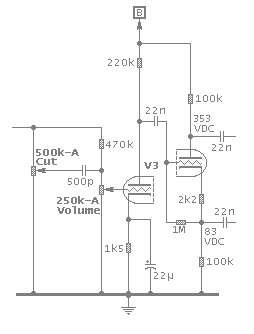 A variation on the typical concertina phase inverter circuit.
A variation on the typical concertina phase inverter circuit.
I used a variation on Simcha Delft's "Moonlight" volume/tone circuit to allow for adjustment of treble response. This circuit is a lot less interactive than the volume/tone pair in a tweed or brown Fender Deluxe, which makes it a lot less "fiddly" when adjusting the tone and/or volume to get the setting you're after.
The corner frequency was well chosen, and gives a nice bit of extra twang when turned up or a nice darker tone without getting too muddy when turned down. With guitar straight in, and the preamp sensitivity switch set for guitar, the tone control has the ability to get into almost Voxy brightness, and when turned up, the amp snarls nicely.
The Output circuit:
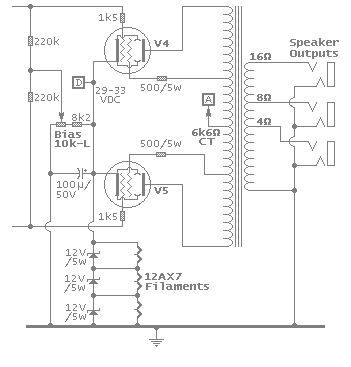 After various online chats with Ken Gilbert on ampage and having heard so many good things about Dr. Z's Route 66 amp, I decided to use an "Ultra-Linear" layout, wherein the screens are hooked to taps in the output transformers' primary winding. The 7591A outputs live happily even though they're above the normal screen voltage limit, thanks to the UL circuit keeping the screens from being too far above the plate and burning up with excess current....
After various online chats with Ken Gilbert on ampage and having heard so many good things about Dr. Z's Route 66 amp, I decided to use an "Ultra-Linear" layout, wherein the screens are hooked to taps in the output transformers' primary winding. The 7591A outputs live happily even though they're above the normal screen voltage limit, thanks to the UL circuit keeping the screens from being too far above the plate and burning up with excess current....
The biasing arrangement may look strange, but the preamp filaments make a fine cathode resistor (as long as they're bypassed!), and that way I get free DC filaments for my preamp! I put a string of Zener diodes to prevent the filaments from going much over their 12.6V rating. I bias the grids positive to achieve the correct bias, because the voltage developed across the three filaments is way more than is needed and would put the outputs nearly in Class-B. Once the bias is set to put the cathodes at 29-33VDC, it sounds great, and the side-effect of the Zeners limiting the cathode voltage rise is that the amp acts like a cathode-biased amp when clean, but tightens up like a Marshall Plexi when cranked!
Oh well, it sounds good to me, and that's what counts, right? }:^)>
The Power Supply circuit:
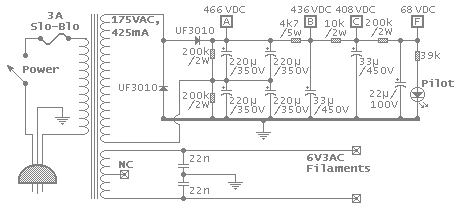 There's not much to say about the power supply - it's a fairly standard affair with the only unusual twist being the 175VAC high-voltage winding and the voltage-doubler circuit layout that it requires....
There's not much to say about the power supply - it's a fairly standard affair with the only unusual twist being the 175VAC high-voltage winding and the voltage-doubler circuit layout that it requires....
I did use an old trick I found in an old Knight KM15 hi-fi kit amp, though. I made the artificial centertap for the 6.3V filament line from a pair of 22nF caps instead of the usual 100 ohm resistors. This breaks the DC path between the filament string and the rest of the circuit, and helps reduce hum by balancing the filament string's AC voltage with respect to the chassis.


